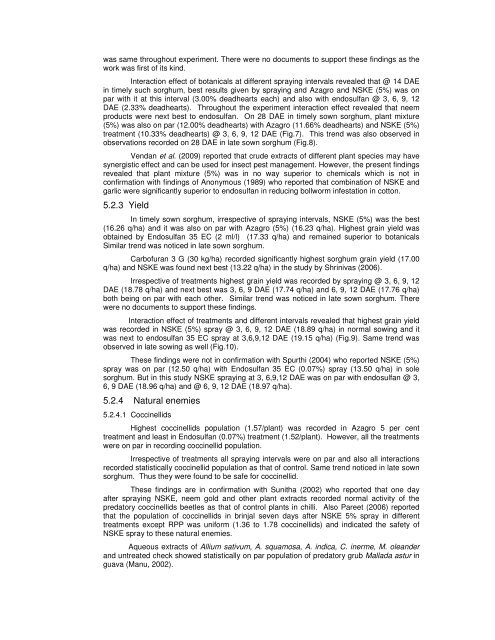NON-CHEMICAL APPROACHES FOR THE MANAGEMENT OF ...
NON-CHEMICAL APPROACHES FOR THE MANAGEMENT OF ...
NON-CHEMICAL APPROACHES FOR THE MANAGEMENT OF ...
You also want an ePaper? Increase the reach of your titles
YUMPU automatically turns print PDFs into web optimized ePapers that Google loves.
was same throughout experiment. There were no documents to support these findings as the<br />
work was first of its kind.<br />
Interaction effect of botanicals at different spraying intervals revealed that @ 14 DAE<br />
in timely such sorghum, best results given by spraying and Azagro and NSKE (5%) was on<br />
par with it at this interval (3.00% deadhearts each) and also with endosulfan @ 3, 6, 9, 12<br />
DAE (2.33% deadhearts). Throughout the experiment interaction effect revealed that neem<br />
products were next best to endosulfan. On 28 DAE in timely sown sorghum, plant mixture<br />
(5%) was also on par (12.00% deadhearts) with Azagro (11.66% deadhearts) and NSKE (5%)<br />
treatment (10.33% deadhearts) @ 3, 6, 9, 12 DAE (Fig.7). This trend was also observed in<br />
observations recorded on 28 DAE in late sown sorghum (Fig.8).<br />
Vendan et al. (2009) reported that crude extracts of different plant species may have<br />
synergistic effect and can be used for insect pest management. However, the present findings<br />
revealed that plant mixture (5%) was in no way superior to chemicals which is not in<br />
confirmation with findings of Anonymous (1989) who reported that combination of NSKE and<br />
garlic were significantly superior to endosulfan in reducing bollworm infestation in cotton.<br />
5.2.3 Yield<br />
In timely sown sorghum, irrespective of spraying intervals, NSKE (5%) was the best<br />
(16.26 q/ha) and it was also on par with Azagro (5%) (16.23 q/ha). Highest grain yield was<br />
obtained by Endosulfan 35 EC (2 ml/l) (17.33 q/ha) and remained superior to botanicals<br />
Similar trend was noticed in late sown sorghum.<br />
Carbofuran 3 G (30 kg/ha) recorded significantly highest sorghum grain yield (17.00<br />
q/ha) and NSKE was found next best (13.22 q/ha) in the study by Shrinivas (2006).<br />
Irrespective of treatments highest grain yield was recorded by spraying @ 3, 6, 9, 12<br />
DAE (18.78 q/ha) and next best was 3, 6, 9 DAE (17.74 q/ha) and 6, 9, 12 DAE (17.76 q/ha)<br />
both being on par with each other. Similar trend was noticed in late sown sorghum. There<br />
were no documents to support these findings.<br />
Interaction effect of treatments and different intervals revealed that highest grain yield<br />
was recorded in NSKE (5%) spray @ 3, 6, 9, 12 DAE (18.89 q/ha) in normal sowing and it<br />
was next to endosulfan 35 EC spray at 3,6,9,12 DAE (19.15 q/ha) (Fig.9). Same trend was<br />
observed in late sowing as well (Fig.10).<br />
These findings were not in confirmation with Spurthi (2004) who reported NSKE (5%)<br />
spray was on par (12.50 q/ha) with Endosulfan 35 EC (0.07%) spray (13.50 q/ha) in sole<br />
sorghum. But in this study NSKE spraying at 3, 6,9,12 DAE was on par with endosulfan @ 3,<br />
6, 9 DAE (18.96 q/ha) and @ 6, 9, 12 DAE (18.97 q/ha).<br />
5.2.4 Natural enemies<br />
5.2.4.1 Coccinellids<br />
Highest coccinellids population (1.57/plant) was recorded in Azagro 5 per cent<br />
treatment and least in Endosulfan (0.07%) treatment (1.52/plant). However, all the treatments<br />
were on par in recording coccinellid population.<br />
Irrespective of treatments all spraying intervals were on par and also all interactions<br />
recorded statistically coccinellid population as that of control. Same trend noticed in late sown<br />
sorghum. Thus they were found to be safe for coccinellid.<br />
These findings are in confirmation with Sunitha (2002) who reported that one day<br />
after spraying NSKE, neem gold and other plant extracts recorded normal activity of the<br />
predatory coccinellids beetles as that of control plants in chilli. Also Pareet (2006) reported<br />
that the population of coccinellids in brinjal seven days after NSKE 5% spray in different<br />
treatments except RPP was uniform (1.36 to 1.78 coccinellids) and indicated the safety of<br />
NSKE spray to these natural enemies.<br />
Aqueous extracts of Allium sativum, A. squamosa, A. indica, C. inerme, M. oleander<br />
and untreated check showed statistically on par population of predatory grub Mallada astur in<br />
guava (Manu, 2002).
















